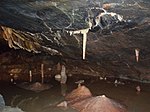Cheddar Complex
Cheddar, SomersetMendip HillsSites of Special Scientific Interest in SomersetSites of Special Scientific Interest notified in 1952

The Cheddar Complex is a 441.3-hectare (1,090-acre) biological Site of Special Scientific Interest near Cheddar around the Cheddar Gorge and north east to Charterhouse in the Mendip Hills, Somerset, England, notified in 1952. The very large area includes 4 SSSIs formerly known as: Cheddar Gorge SSSI; August Hole/Longwood Swallet SSSI; GB Cavern Charterhouse SSSI; and Charterhouse on-Mendip SSSI. It is part owned by the National Trust, commercial landowners including the Marquess of Bath's Longleat Estate; and part managed by the Somerset Wildlife Trust.
Excerpt from the Wikipedia article Cheddar Complex (License: CC BY-SA 3.0, Authors, Images).Cheddar Complex
The Cliffs, Sedgemoor
Geographical coordinates (GPS) Address Nearby Places Show on map
Geographical coordinates (GPS)
| Latitude | Longitude |
|---|---|
| N 51.28082 ° | E -2.76844 ° |
Address
Cox's Cave and The Crystal Quest
The Cliffs
BS27 3QE Sedgemoor
England, United Kingdom
Open on Google Maps







